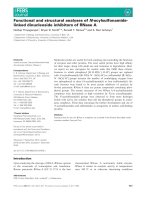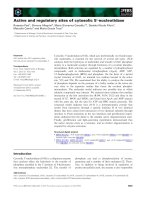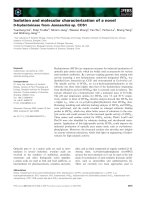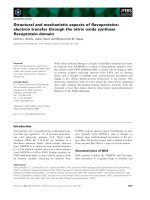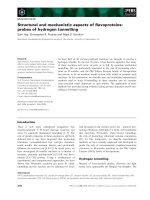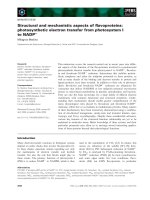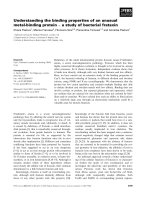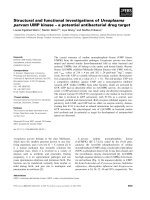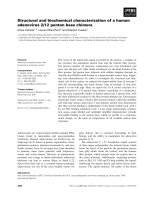Báo cáo khoa học: Cholinoceptive and cholinergic properties of cardiomyocytes involving an amplification mechanism for vagal efferent effects in sparsely innervated ventricular myocardium ppt
Bạn đang xem bản rút gọn của tài liệu. Xem và tải ngay bản đầy đủ của tài liệu tại đây (940.48 KB, 15 trang )
Cholinoceptive and cholinergic properties of
cardiomyocytes involving an amplification mechanism for
vagal efferent effects in sparsely innervated ventricular
myocardium
Yoshihiko Kakinuma
1
, Tsuyoshi Akiyama
2
and Takayuki Sato
1
1 Department of Cardiovascular Control, Kochi Medical School, Nankoku, Japan
2 Department of Cardiac Physiology, National Cardiovascular Center Research Institute, Suita, Japan
Introduction
Our previous studies showed that an oral low dose of
donepezil, an acetylcholinesterase inhibitor and anti-
Alzheimer’s disease drug, prevented ventricular remod-
eling and dysfunction after large myocardial infarction
Keywords
acetylcholine; cardiomyocytes; donepezil;
energy metabolism; non-neuronal
cholinergic system
Correspondence
Y. Kakinuma, Department of Cardiovascular
Control, Kochi Medical School, Nankoku,
Kochi 783-8505, Japan
Fax: +81 88 880 2310
Tel: +81 88 880 2587
E-mail:
(Received 13 May 2009, revised 8 July
2009, accepted 10 July 2009)
doi:10.1111/j.1742-4658.2009.07208.x
Our recent studies have shown that, as indicated by vagal stimulation, an
acetylcholinesterase inhibitor donepezil, an anti-Alzheimer’s disease drug,
prevents progression of heart failure in rats with myocardial infarction,
and activates a common cell survival signal shared by acetylcholine (ACh)
in vitro. On the basis of this and evidence that vagal innervation is extremely
poor in the left ventricle, we assessed the hypothesis that ACh is produced
by cardiomyocytes, which promotes its synthesis via a positive feedback
mechanism. Rat cardiomyocytes expressed choline acetyltransferase (ChAT)
in the cytoplasm and vesicular acetylcholine transporter with the vesicular
structure identified by immunogold electron microscopy, suggesting that
cardiomyocytes possess components for ACh synthesis. Intracellular ACh in
rat cardiomyocytes was identified with physostigmine or donepezil. How-
ever, with atropine, the basal ACh content was reduced. In response to exog-
enous ACh or pilocarpine, cardiomyocytes increased the transcriptional
activity of the ChAT gene through a muscarinic receptor and ChAT protein
expression, and, finally, the intracellular ACh level was upregulated by pilo-
carpine. Knockdown of ChAT by small interfering RNA accelerated cellular
energy metabolism, which is suppressed by ACh. Although physostigmine
had a minimal effect on the ChAT promoter activity by inhibiting acetylcho-
linesterase, donepezil resulted in elevation of the activity, protein expression
and intracellular ACh level even in the presence of sufficient physostigmine.
Orally administered donepezil in mice increased the ChAT promoter activity
in a reporter gene-transferred quadriceps femoris muscle and the amount of
cardiac ChAT protein. These findings suggest that cardiomyocytes possess
an ACh synthesis system, which is positively modulated by cholinergic stim-
uli. Such an amplification system in cardiomyocytes may contribute to the
beneficial effects of vagal stimulation on the ventricles.
Abbreviations
ACh, acetylcholine; ChAT, choline acetyltransferase; ChAT KO, cell transfected with the choline acetyltransferase sequence-specific
microRNA expression vectors; DAPI, 4¢,6-diamidino-2-phenylindole; HIF, hypoxia-inducible factor; miRNA, microRNA; IPHC,
isopropylhomocholine chloride; MTT, 3-(4,5-dimethylthiazol-2-yl)-2,5-diphenyl tetrazolium bromide; siRNA, small interfering RNA; VAChT,
vesicular acetylcholine transporter.
FEBS Journal 276 (2009) 5111–5125 ª 2009 The Authors Journal compilation ª 2009 FEBS 5111
in rats without a bradycardiac effect, and that vagal
nerve stimulation protected the heart against ischemia-
induced ventricular tachyarrhythmias independently of
a heart rate-slowing mechanism [1–3]. We also showed
that pretreatment with acetylcholine (ACh) salvaged
in vitro cardiomyocytes from prolonged hypoxia-
induced cell death by preserving mitochondrial function
and activating cell survival signals, including phospho-
inositide-3-kinase ⁄ Akt ⁄ hypoxia-inducible factor (HIF)-
1a ⁄ vascular endothelial growth factor [4], and that ACh
prevented hypoxia-induced loss of gap-junction chan-
nels, maintaining cell-to-cell communication and electri-
cal stability [4,5]. These results initially prompted us to
speculate that such beneficial effects were achieved by
direct cellular actions of ACh, which appeared to be
released from the vagal nerve endings at ventricular
walls and to be rapidly broken down by acetylcholines-
terase. However, this speculation concerning the
mechanism of the beneficial effects of ACh has been
challenged by accumulating evidence of the sparseness
of cholinergic innervation of the ventricular myo-
cardium, except for the specialized conduction system
[6–9]. Furthermore, our recent study unexpectedly
showed that, in cultured cardiomyocytes, donepezil
directly activated the same cell survival pathway as ACh
did, although there were no cholinergic neurons in the
culture. Consequently, these results allow us to propose
a working hypothesis that donepezil directly stimulates
cardiomyocytes to synthesize ACh de novo.
Although ACh was first identified as a vagal efferent
neurotransmitter, ‘parasympathin’, recent studies have
revealed that non-neuronal cells in animals and
humans synthesize, store and release ACh [10,11]. In
the non-neuronal cholinergic system, ACh is constitu-
tively produced to act locally as an autocrine or para-
crine mediator via cellular membrane-bound receptors
and intracellular signaling proteins. Therefore, we
hypothesize that cardiomyocytes possess the properties
of the non-neuronal cholinergic system and that the
cholinergic system in cardiomyocytes is activated by
donepezil. An earlier observation, which appears to
support our hypothesis, was reported by Kawada et al.
[12], who measured myocardial interstitial ACh con-
centrations in the left ventricular free wall with an
in vivo microdialysis technique. In vagotomized cats,
acute myocardial ischemia induced a large increase in
ACh concentration in the dialysate. Although the
ischemically injured nerve ending of the vagus was
reported to be the only source of ACh, we now pre-
sume that the ischemic cardiomyocyte is another possi-
ble source of ACh.
To test our hypothesis and clarify a molecular and
cellular basis for the beneficial effects of donepezil, in
the present study we focused our efforts on the follow-
ing points. First, we investigated intracellular pathways
for ACh production in cardiomyocytes. Second, we
determined the intracellular concentrations and loca-
tions of ACh. Third, we examined the effects of
donepezil on the intracellular ACh production path-
ways and the intracellular levels of ACh. Finally, we
evaluated the biological significance of cardiac non-
neuronal ACh system by genetic interference in intrin-
sic ACh synthesis. The present results not only support
our hypothesis, but also reveal a novel mechanism for
a direct action of vagally released ACh on the ventric-
ular cardiomyocytes, i.e. amplification of the vagal
effect via ACh-induced ACh production in cardio-
myocytes. This mechanism would answer the question
that was raised by Rosen and Hoffman [13] three dec-
ades ago: ‘how can the vagus directly exert its benefi-
cial effects on the diseased ventricle in spite of its
sparse innervation of the ventricular myocardium
except for the conduction system?’
Results
Choline acetyltransferase (ChAT) and vesicular
acetylcholine transporter (VAChT) expressed in
cardiomyocytes
Immunoreactivity for ChAT, an essential enzyme for
ACh synthesis from choline and acetyl-coenzyme A,
was detected in the cytoplasm of neonatal and adult
rat cardiomyocytes (Fig. 1A,B). Punctate fluorescent
signals for VAChTs, indispensable intracellular trans-
porters of synthesized ACh, were also distributed
throughout the cytoplasm (Fig. 1C,D). In agreement
with the immunocytochemical results, electron micro-
scopic examination of the rat heart also confirmed that
gold particles conjugated with antibodies against
VAChT were located in the membrane structures
between the muscle fibers (Fig. 1E). Immunoblot anal-
ysis showed that both ChAT and VAChT proteins are
expressed in cardiomyocytes (Fig. 1F). These results
suggest that cardiomyocytes possess ACh-producing
properties.
Basal ACh level detected in cardiomyocytes
The basal level of ACh was evaluated by HPLC, using
rat cultured cardiomyocytes. During the procedures for
measurement, without the use of an acetylcholinester-
ase inhibitor, physostigmine, ACh was not detectable
in cardiomyocytes at all (Fig. 2). However, in the pres-
ence of 0.1 mmolÆL
)1
physostigmine during measure-
ment, which is adequate for inhibition, the basal ACh
de novo ACh synthesis induced by ACh in cardiomyocytes Y. Kakinuma et al.
5112 FEBS Journal 276 (2009) 5111–5125 ª 2009 The Authors Journal compilation ª 2009 FEBS
Fig. 1. Rat cardiomyocytes express crucial
components of ACh synthesis, ChAT and
VAChT. Rat neonatal and adult cardiomyo-
cytes expressed ChAT immunoreactivity in
the cytoplasm (red). The red signals were
detected throughout the cardiomyocytes.
Green: F-actin. Bar: 20 lm [(A) neonatal; (B)
adult]. VAChT signals were also detected in
both neonatal and adult rat cardiomyocytes
(red), although in a punctuate fashion (blue,
DAPI). Bar: 20 lm [(C) neonatal; (D) adult].
Immunogold electron microscopy demon-
strated vesicle-like structures with VAChT
immunoreactivity in adult rat cardiomyo-
cytes. Diameter of each gold particle:
15 nm. Bar: 50 nm (E). Western blot analy-
sis showed that rat neonatal cardiomyo-
cytes expressed both ChAT and VAChT with
proper molecular masses (F).
Y. Kakinuma et al. de novo ACh synthesis induced by ACh in cardiomyocytes
FEBS Journal 276 (2009) 5111–5125 ª 2009 The Authors Journal compilation ª 2009 FEBS 5113
level was determined to be 2.93 ± 0.63 nmolÆL
)1
(n = 10) in rat cardiomyocyte lysates, and further-
more, even with donepezil, another acetylcholinesterase
inhibitor, ACh was detected in cardiomyocytes (Fig. 2).
Effects of muscarinic agonists on ChAT
transcription and translation
The HEK293 cells used for transfection in the reporter
assay were shown to express the components required
for ACh synthesis, i.e. ChAT, VAChT and muscarinic
ACh receptor subtype (m)2 by immunocytochemical
analysis. RT-PCR analysis also revealed that m1, m2,
m5, nicotinic receptor subtype (a)3 and a4 mRNAs
are expressed in HEK293 cells (Fig. 3A).
A reporter assay using a reporter vector, transfected
into HEK293 cells, with a regulatory promoter region
of rat ChAT showed that ACh (1 mmolÆL
)1
) and pilo-
carpine (1 mmolÆL
)1
) increased the transcriptional
activity of ChAT (Fig. 3A,B). Within 4–8 h, the lucif-
erase activity driven by the ChAT promoter was signif-
icantly enhanced by ACh (862.0 ± 115.0%, P < 0.01,
n = 9) and pilocarpine (961.0 ± 8.5%, P < 0.01,
n = 9). Increases in ChAT transcription activities were
suppressed by atropine (1 mmolÆL
)1
). In agreement
with the transcriptional activation, the protein levels of
ChAT in rat cardiomyocytes were also upregulated by
ACh (267.8 ± 30.9%, P < 0.05, n = 6) and pilocar-
pine (217.5 ± 14.6%, P < 0.01, n = 6) (Fig. 3A,B).
These effects of muscarinic agonists on ChAT protein
expression were subsequently blocked by atropine.
Effects of muscarinic agonist on the ACh level in
cardiomyocytes
The basal level of ACh in rat cardiomyocytes was
determined in the presence of physostigmine (Fig. 4A).
Pretreatment with atropine (1 mmolÆL
)1
) significantly
lowered the ACh level to 45.7 ± 7.9% (P < 0.05). By
contrast, treatment with pilocarpine (1 mmolÆL
)1
) sig-
nificantly increased the ACh level in rat cardiomyo-
cytes to 255.0 ± 28.0% of the basal level of control
(P < 0.05, n = 13) (Fig. 4B). These results suggest
that cardiomyocytes constitutively produce and release
ACh, and that the released ACh, in turn, stimulates
cardiomyocytes to synthesize ACh via muscarinic
receptors; that is, there is an autocrine–paracrine
cardiac ACh synthesis system.
Cellular effects of small interfering RNA (siRNA)
for ChAT in HEK293 cells
When compared with nontransfected or unrelated
siRNA-transfected HEK293 cells, ChAT-knockdown
cells (siRNA-transfected HEK293 cells) had few sig-
nals for ChAT and low expression of ChAT protein,
as also shown by western blot analysis (Fig. 5A). It
has been shown that 3-(4,5-dimethylthiazol-2-yl)-2,5-
diphenyl tetrazolium bromide (MTT) activity is
reflected by cellular energy metabolism; therefore, even
with comparable cell numbers, MTT activity can
decline when energy metabolism is suppressed [14,15].
MTT deposits partially overlapped with mitochondria,
as indicated by DePsipher, not only in HEK293 cells
but also in rat cardiomyocytes (Fig. 5B). The MTT
activities in HEK293 cells were significantly suppressed
by ACh (1 mmolÆL
)1
) to 79.2 ± 5.0% (P < 0.01)
(Fig. 5B). The inhibitory effect of ACh on the MTT
activity was also verified by a reduction of oxygen con-
sumption in ACh-treated HEK293 cells. Likewise, oxy-
gen consumption was reduced by ACh in rat
cardiomyocytes (Fig. 5B). By contrast, the knockdown
of ChAT reciprocally increased MTT activity to
149.5 ± 3.1% (P < 0.01) (Fig. 5C).
Finally, to further assess the role of synthesized
ACh, the amount of which seems to be very small in
cell lysates, oxygen consumption was measured in real
time using stable HEK293 cells transfected with the
ChAT sequence-specific microRNA (miRNA) expres-
sion vectors (ChAT KOs). As shown in Fig. 5D,
ChAT KOs definitely consumed more oxygen than the
negative control vector transfectants, suggesting that
intrinsic ACh synthesized by cells definitely plays a
biologically significant role in suppressing cellular
energy metabolism.
Effects of donepezil on ACh levels in
cardiomyocytes
When compared with the basal level of ACh in control
rat cardiomyocytes treated with physostigmine alone,
Fig. 2. ACh is present in rat cardiomyocytes. In the presence of
0.1 mmolÆL
)1
physostigmine during measurement, the basal ACh
level in rat cardiomyocytes, evaluated by HPLC, was 2.93 ± 0.63
nmolÆL
)1
(n = 10) (black area in the chromatogram) in comparison
with 20 n
M IPHC (gray area in the chromatogram). With 1 lmolÆL
)1
donepezil, ACh was also detected in cardiomyocytes.
de novo ACh synthesis induced by ACh in cardiomyocytes Y. Kakinuma et al.
5114 FEBS Journal 276 (2009) 5111–5125 ª 2009 The Authors Journal compilation ª 2009 FEBS
at a concentration adequate for acetylcholinesterase
inhibition (0.1 mmolÆL
)1
) [16], a higher level of ACh
was found in donepezil-treated cardiomyocytes
(384.6 ± 102.7%, P < 0.05) (Fig. 6). The effect of
donepezil was blocked by atropine (1 mmolÆL
)1
), but
there was still a significant difference in the ACh level
between the cardiomyocytes treated with donepezil
plus atropine and those treated with atropine
(225.0 ± 43.0% versus 45.7 ± 7.9%, P < 0.01). The
facts that donepezil elevated the ACh level in control
cardiomyocytes and that the effect was only partially
blocked by atropine suggested that donepezil has a
mechanism of action that is independent of acetylcho-
linesterase inhibition or muscarinic receptors.
Fig. 3. Transcription and translation of ChAT is upregulated through a muscarinic receptor. HEK293 cells expressed immunoreactivities of
ChAT, VAChT, and m2. Red: m2, ChAT, and VAChT, respectively. Blue: DAPI. Bar: 20 lm. HEK293 cells expressed mRNAs of cholinergic
receptors, including m1, m2, and m5, as well as a3 and a4 (A), as evaluated by RT-PCR. Rat ChAT promoter activity, evaluated by using
HEK293 cells transfected with the reporter vectors, and ChAT protein expression in rat cardiomyocytes were increased by 1 mmolÆL
)1
ACh
(blue bars) (A) and 1 mmolÆL
)1
pilocarpine (green bars) (B). The promoter activity and the protein level induced by each agonist peaked at
8 h, however, 1 mmolÆL
)1
atropine inhibited ChAT transcription and translation, resulting in a decrease in the peak level.
Y. Kakinuma et al. de novo ACh synthesis induced by ACh in cardiomyocytes
FEBS Journal 276 (2009) 5111–5125 ª 2009 The Authors Journal compilation ª 2009 FEBS 5115
Effects of donepezil on ChAT transcription and
translation
The effects of donepezil on the transcriptional activity
for ChAT in HEK293 cells, transfected with the repor-
ter vectors, and on its protein expression in rat cardio-
myocytes are illustrated in Fig. 7. In comparison with
donepezil, physostigmine did not increase the promoter
activity for ChAT in the reporter vector-transfected
HEK293cells (Fig. 7A). By contrast, a promoter assay
revealed that donepezil gradually increased the ChAT
promoter activity (267.0 ± 14.1%, P < 0.01), and
that the time course was quite different from that of
ACh (Fig. 7B). Similarly, ChAT protein expression
was slowly upregulated by donepezil (420.0 ± 31.6%,
P < 0.01) in rat cardiomyocytes (Fig. 7B). These
results suggest that donepezil, unlike physostigmine,
activates the ACh synthesis system. This in vitro effect
of donepezil on ChAT transcription was also observed
in vivo. Orally administered donepezil (1 week) also
elevated ChAT protein expression in the heart, as eval-
uated by immunohistochemical and western analysis
(Fig. 7C).
An in vivo reporter assay was conducted to investigate
the effect of donepezil on murine skeletal muscle, as it is
a more convenient target for a gene transfer approach
with sonoporation than the heart. The effect of oral
donepezil on ChAT promoter activity in quadriceps fem-
oris muscles is shown in Fig. 8. When compared with the
skeletal muscles of untreated mice, those of donepezil-
treated mice exhibited increased promoter activity for
ChAT (380.0 ± 82.0% of control, P < 0.05).
Fig. 4. ACh synthesis in rat cardiomyocytes is activated by the muscarinic agonist pilocarpine. The basal ACh level in rat cardiomyocytes,
standardized as 100%, was reduced to 45.7 ± 7.9% (P < 0.05) in the presence of 1 mmolÆL
)1
atropine with physostigmine (atropine) (A).
The ACh level, measured with physostigmine, was increased to 255.0 ± 28.0% (P < 0.05, n = 8) by 12 h of treatment with pilocarpine
(1 mmolÆL
)1
) (green bar) (B).
Fig. 5. ChAT negatively modulates mitochondrial respiratory activity. Knockdown of the ChAT gene by ChAT-specific siRNA verified the
reduction of endogenous ChAT immunoreactivities in HEK293 cells, as compared with the levels in nontreated cells and unrelated siRNA-
transfected cells. Red: ChAT. Blue: DAPI. Bar: 20 lm. Reduced expression of endogenous ChAT protein caused by the siRNA in HEK293
cells was also verified by western blot analysis (A). Red signals represented by mitochondria in HEK293 cells using DePsipher partially over-
lapped with MTT deposits (black). Bar: 20 lm. ACh (1 mmolÆL
)1
)-treated HEK293 cells decreased their oxygen consumption within 3 h and
decreased their MTT activity to 79.2 ± 5.0% (blue bar), as compared with nontreated HEK293 cells (P < 0.01, n = 8). Likewise, ACh also
reduced oxygen consumption in rat cardiomyocytes, in which several MTT deposits (black) also colocalized with DePsipher signals (red). Bar:
20 lm (B). However, ChAT knockdown in HEK293 cells conversely increased MTT activity to 149.5 ± 3.1% (P < 0.01, n = 15) (C). ChAT
KOs (blue and green lines), HEK293 cells stably transfected with the miRNA expression vectors possessing specific human ChAT
sequences, showed greater acceleration of oxygen consumption than negative control cells (negative control, dotted lines), as depletion of
oxygen contents in the culture medium of ChAT KOs was greater than in the negative control. Representative data from two clones in each
group are shown (D).
de novo ACh synthesis induced by ACh in cardiomyocytes Y. Kakinuma et al.
5116 FEBS Journal 276 (2009) 5111–5125 ª 2009 The Authors Journal compilation ª 2009 FEBS
Y. Kakinuma et al. de novo ACh synthesis induced by ACh in cardiomyocytes
FEBS Journal 276 (2009) 5111–5125 ª 2009 The Authors Journal compilation ª 2009 FEBS 5117
Discussion
The present results suggest that cardiomyocytes possess
an ACh-producing pathway and synthesize a basal
level of ACh constitutively, and that exogenously
administered and endogenously produced ACh stimu-
lates the ACh-producing pathway, mainly via musca-
rinic receptors. On the basis of these results, we
propose that the cholinoceptive cholinergic properties
of cardiomyocytes could act as a positive feedback
system for ACh synthesis in an autocrine ⁄ paracrine
manner. Another important result is that, concerning
the biological significance, the intracellular ACh syn-
thesis system plays a role in negatively regulating
energy metabolism in cardiomyocytes. In addition to
these results, we showed that donepezil activates the
ACh-producing pathway and elevates the ACh level in
cardiomyocytes via both acetylcholinesterase-inhibitory
and acetylcholinesterase-independent mechanisms.
Therefore, donepezil is a potent upregulator of the
ACh level in the ventricular myocardium, in spite of
the sparseness of cholinergic innervation of the ventric-
ular myocardium (except for the specialized conduc-
tion system).
Our previous studies demonstrated that vagal stimu-
lation improves the survival rate of rats with heart fail-
ure by inhibition of myocardial infarction-induced
fatal arrhythmia and remodeling of the left ventricle
[2,17], and that ACh protects cardiomyocytes from
hypoxia-induced apoptosis through the phosphoinosi-
tide-3-kinase ⁄ Akt ⁄ HIF-1a ⁄ vascular endothelial growth
factor pathway [4]. These results suggest that ACh
plays beneficial roles in both salvaging cardiomyocytes
and suppressing arrhythmia. However, recent findings
have demonstrated that vagal nerve endings are rarely
detected in the left ventricle in humans, guinea pigs
and rats, although the innervation may vary between
species [6–9,18]. Consequently, there is a discrepancy
between the cardioprotective effects of ACh on cardio-
myocytes and the paucity of vagal nerve endings in the
left ventricle.
Since previous studies pioneered by Kawashima,
Fujii [19,20] and Wessler [21,22], showing that ACh is
synthesized in non-neuronal cells, i.e. T-lymphocytes
and bronchial epithelial cells, accumulating experimen-
tal evidence has revealed that ACh is widely present in
both prokaryotic and eukaryotic non-neuronal cells,
and is also present in bacteria, protozoa, algae, and
primitive plants. Therefore, ACh is considered to have
appeared very early in the evolutionary process and to
play another significant role, not as a neurotransmitter
but as a trophic factor. However, there are no reports
showing that ACh is synthesized in cardiomyocytes.
As demonstrated in the present study, rat cardio-
myocytes possessed essential components for ACh syn-
thesis, ChAT and VAChT, and the content of ACh in
cultured cardiomyocytes was measurable. Surprisingly,
the protein expression level and transcriptional activity
of ChAT were elevated by ACh or pilocarpine through
a muscarinic receptor, and the ACh level in cardio-
myocytes was upregulated by pilocarpine. This sug-
gests that cardiomyocytes have a positive feedback
mechanism in ACh synthesis, and reinforces the previ-
ous finding that chronic vagal stimulation suppressed
remodeling of the myocardial infarction-induced failing
heart despite the extreme sparseness of vagal nerve
endings in the ventricle. In other words, ACh released
from vagal nerve endings sequentially might activate
local ACh synthesis in neighboring cardiomyocytes in
a paracrine fashion, and propagation of ACh synthesis
might progress throughout the heart.
As evaluated by HPLC, the ACh level was very low
in cardiomyocyte cell lysates. However, according to
our data, the average concentration of ACh in one car-
diomyocyte was estimated to be in the millimoles per
liter range. This was surprisingly comparable to the
data on ACh levels in endothelial cells reported by
Malo et al. [23], who demonstrated that one brain
endothelial cell, engineered to express ChAT, produced
as much as 7 mmolÆL
)1
of ACh. This study strongly
suggests that, if cells possess functional ChAT, ACh
could reach an intracellular level up to 1 mmolÆL
)1
.
Furthermore, results obtained with stable transfectants
of ChAT KOs suggest that the ACh synthesized at the
cellular levels plays a pivotal role in suppressing cellu-
lar energy metabolism.
Fig. 6. Donepezil increases the ACh level in rat cardiomyocytes.
even in the presence of physostigmine, and the effect is partially
attenuated by atropine. In rat cardiomyocytes treated with 1 lmolÆL
)1
donepezil for 20 h, the ACh level was further increased to
384.6 ± 102.7% (P < 0.05, n = 10), even in the presence of physo-
stigmine (red bar). In contrast, 1 mmolÆL
)1
atropine tended to atten-
uate the ACh level induced by donepezil to 225.0 ± 43.0%
(atropine) (P < 0.05, n = 6).
de novo ACh synthesis induced by ACh in cardiomyocytes Y. Kakinuma et al.
5118 FEBS Journal 276 (2009) 5111–5125 ª 2009 The Authors Journal compilation ª 2009 FEBS
Although a series of our experimental studies showed
that chronic vagal nerve stimulation exerts its beneficial
effects on ventricular myocardium via muscarinic ACh
receptors, such a therapy needs an invasive surgical
procedure. A noninvasive pharmacological treatment
with oral donepezil could be a potential alternative to
chronic vagal nerve stimulation therapy. Donepezil was
originally developed as a centrally acting inhibitor of
acetylcholinesterase, and is currently available for the
treatment of Alzheimer’s disease [24]. However, several
in vitro studies also suggest that the neuroprotective
actions of donepezil could depend principally on its
pharmacological properties other than acetylcholines-
terase inhibition. For example, in an earlier study,
Fig. 7. Donepezil activates rat ChAT pro-
moter activity in HEK293 cells and ChAT
protein expression in rat cardiomyocytes
in vitro and in vivo. Rat ChAT promoter
activity was not affected by physostigmine
(A); in contrast, it was increased by 1 lmo-
lÆL
)1
donepezil within 20 h (267.0 ± 14.0%,
P < 0.01, n = 6), and this effect was
blocked by atropine. Concomitantly, the
protein expression level of ChAT was also
increased by donepezil in rat cardiomyo-
cytes (red bar) (B). Orally administered
donepezil also elevated ChAT protein
expression and immunoreactivities in the
heart. Representative results were shown.
Blue: DAPI. Red: ChAT. Bar: 50 lm (C).
Y. Kakinuma et al. de novo ACh synthesis induced by ACh in cardiomyocytes
FEBS Journal 276 (2009) 5111–5125 ª 2009 The Authors Journal compilation ª 2009 FEBS 5119
Kato et al. [16] revealed that donepezil increased ChAT
activity in cholinergic neuronal cells, as compared with
other types of acetylcholinesterase inhibitors, and men-
tioned the specific characteristics of donepezil. In agree-
ment with that study, the present results show that
de novo synthesis of ACh in cardiomyocytes was signifi-
cantly promoted by donepezil, even in the presence of a
dose of physostigmine sufficient to completely inhibit
endogenous acetylcholinesterase [25–27], suggesting
that donepezil has the ability to activate the ACh syn-
thesis system in cardiomyocytes. Although a precise
mechanism for the intracellular signal transduction of
donepezil remains to be clarified, in addition to acetyl-
cholinesterase inhibition, donepezil seems to activate
ChAT transcription and translation in cardiomyocytes
and skeletal muscle cells.
In previous studies, we showed that ACh is involved
in enhanced protein stability of HIF-1a, which nega-
tively regulates cellular energy metabolism [4,14]. This
finding is strongly supported by other studies showing
that HIF-1a is responsible for inhibition of mitochon-
drial function [28–30]. As indicated in the present
study, exogenous ACh decreased oxygen consumption,
resulting in downregulation of energy metabolism. By
contrast, ChAT knockdown by transfection of its
siRNA or the stable transfectants increased MTT
activities and oxygen consumption. Taken together,
these results suggest that intrinsic ACh, constitutively
produced even at the basal level, contributes to the
negative regulation of energy metabolism, leading to
suppression of the function, and indicate that the
pharmacological activation of the de novo ACh pro-
duction pathway results in suppression of oxygen
consumption.
The increased production of reactive oxygen species
in mitochondria in the case of enhanced oxygen
demand causes cellular damage and death, i.e., apopto-
sis, if not balanced with the capacities of the specific
scavengers. As already reported in chronic heart fail-
ure, cardiomyocytes are often exposed to such an
imbalanced condition, resulting in apoptosis. In previ-
ous studies, we showed that treatment with ACh pro-
tects cardiomyocytes against ischemia and hypoxia
through upregulation of antiapoptotic factors and
downregulation of proapoptotic factors [3,4,14]. Fur-
thermore, the present study reveals that such a cholin-
ergic system is not specific for the central nervous
system, but is evolutionarily conserved by non-neuro-
nal cells, i.e. cardiomyocytes, in terms of ‘a molecular
brake’ on cellular energy metabolism. So far, therapeu-
tic modalities have not been considered from this point
of view. Therefore, pharmacological activation of the
intrinsic ACh-producing system in the myocardium
with donepezil would be a new therapeutic strategy
against chronic heart failure.
Limitations
Quantification of the level of ACh in cells is technically
difficult, owing to the rapid degradation by acetylcho-
linesterase. Therefore, it always requires acetylcholines-
terase inhibitors. As HPLC is the only tool available
with which to quantify ACh, and a highly specific anti-
body against ACh cannot be obtained at present, it is
quite difficult to perform real-time analysis of changes
in intracellular ACh in various conditions. Further-
more, owing to a lack of knowledge of the receptor,
binding partners and action mechanisms for donepezil,
it is still difficult to completely differentiate the acetyl-
cholinesterase inhibitory action from acetylcholin-
esterase-independent action. The development or
introduction of new technologies is necessary for the
detailed investigation of the intracellular ACh synthesis
system.
Conclusions
The present study indicates that cardiomyocytes have
an ACh synthesis system that is activated by musca-
rinic agonists, suggesting that the cholinoceptive cho-
linergic properties of cardiomyocytes could act as an
amplification mechanism for vagal efferent effects in
the sparsely innervated ventricular myocardium. The
anti-Alzheimer’s disease drug donepezil also stimulates
this ACh synthesis system and increases the ACh level
in cardiomyocytes by mechanisms other than acetyl-
cholinesterase inhibition.
Fig. 8. Donepezil activates the transcriptional activity of ChAT in
quadriceps femoris muscles. Mice given oral donepezil showed an
increase in ChAT promoter activity in the quadriceps femoris mus-
cle (380.0 ± 82.0%, P < 0.05, n = 7) transfected by the reporter
vectors, as compared with nontreated mice.
de novo ACh synthesis induced by ACh in cardiomyocytes Y. Kakinuma et al.
5120 FEBS Journal 276 (2009) 5111–5125 ª 2009 The Authors Journal compilation ª 2009 FEBS
Experimental procedures
The investigation conformed to the Guide for the Care and
Use of Laboratory Animals published by the US National
Institutes of Health. Care and use of the animals were also
in strict accordance with the guiding principles of the Physi-
ological Society of Japan.
Materials and reagents
ACh, the muscarinic receptor agonist pilocarpine and the
muscarinic receptor antagonist atropine were purchased
from Sigma-Aldrich (St Louis, MO, USA). The acetylcho-
linesterase inhibitor physostigmine was obtained from
Wako Pure Chemical Industries (Osaka, Japan). Donepezil,
another acetylcholinesterase inhibitor, was a generous gift
from Eisai (Tokyo, Japan).
Cell culture
Neonatal cardiomyocytes were obtained from the hearts of
rats aged 2–3 days. Cells were isolated with a mixture of
type II and type IV collagenases (Worthington Biochemical
Corporation, Lakewood, NJ, USA) [31,32]. The purity of
cardiomyocytes in a culture dish was more than 92%. They
were cultured on glass-bottomed dishes precoated with 1%
gelatin and 50 lgÆmL
)1
fibronectin, or cultured in ordinary
culture dishes coated with gelatin, for assessment of ACh
content in cardiomyocytes. Adult cardiomyocytes of rats
and mice were isolated with a mixture of type II and
type IV collagenases and type XIV protease (Sigma-
Aldrich), and inoculated onto dishes precoated with a mix-
ture of gelatin, fibronectin, and laminin [33]. HEK293 cells
were transfected with a reporter vector driven by a rat
promoter region ()1.9 kb) for ChAT.
Immunocytochemistry and confocal microscopy
Rat cultured cardiomyocytes from neonates and adults were
fixed in 4% paraformaldehyde, permeabilized with 0.1%
Triton X-100, and blocked with 1% BSA; this was followed
by reaction with primary antibodies, including antibody
against ChAT (Chemicon International, Temecula, CA,
USA) diluted 1 : 100, antibody against VAChT (Santa Cruz
Biotechnology, Santa Cruz, CA, USA) diluted 1 : 100, and
antibody against m2 (Alomone Lbs Ltd, Jerusalem, Israel)
diluted 1 : 100. For F-actin staining in cardiomyocytes,
Alexa Fluor 488 phalloidin (Molecular Probes, Invitrogen,
Carlsbad, CA, USA) was used, and 4¢,6-diamidino-2-pheny-
lindole (DAPI) (Dojindo, Kumamoto, Japan) was used for
nuclear staining. Hearts from mice treated with oral
donepezil (5 mgÆkg
)1
Æday
)1
) for 1 week (n = 6) were
processed for preparation of cryostat sections, and this was
followed by reaction with antibodies against ChAT (Chem-
icon) and secondary antibodies. After washing, secondary
antibodies conjugated with fluorescent marker were applied,
and a confocal laser scanning microscopic analysis (FV300;
Olympus, Tokyo, Japan) was performed.
Immunogold electron microscopy
Adult rat cardiomyocytes were isolated and collected by
centrifugation at 200 g for 10 min. Packed adult cardio-
myocytes mixed with agarose were fixed in 4% paraformal-
dehyde, permeabilized, and washed thoroughly. The
embedded block of the sample was sectioned at a thickness
of 40 lm with a vibratome, and incubated with the anti-
body against VAChT diluted 1 : 100. For the secondary
reaction, the sample section was incubated with 15 nm
gold-conjugated goat anti-(rabbit IgG) (Nanoprobes)
diluted 1 : 100. After immunostaining, the section was fixed
with 1% osmium tetroxide and embedded in Eponate 12
(Ted Pella, Redding, CA, USA). Immunogold stains were
examined by transmission electron microscopy (H-7100;
Hitachi High-Technologies Corporation, Tokyo, Japan).
RT-PCR
Total RNA was extracted from cells using TRIzol reagent
(Invitrogen), according to the manufacturer’s protocol.
Total RNA (1 lg) was reverse-transcribed to obtain single-
stranded cDNA, using a kit (Toyobo, Tokyo, Japan). Spe-
cific primers for human cholinergic receptors were designed
as described previously [34,35]. PCR amplification was
performed with 40 cycles of the reaction, with annealing
temperatures of 60 °C. Primer sequences were as follows:
m1 (forward), 5¢-TGAGGGCTCACCAGAGACT-3¢;m1
(reverse), 5¢-GTCCAGGTGAGGATGAAGG-3¢; m2 (for-
ward), 5¢-ACAAGGAAGGATAGTGAAGCC-3¢;m2
(reverse), 5¢-CATCTCCATTCTGACCTGAAG-3¢; m5 (for-
ward), 5¢-TCTGTTCAGATCCTGCTTG-3¢; m5 (reverse),
5¢-TGCTGGAGACAGAAGGTAGT-3¢; a3 (forward), 5¢-
CAGAGTCCAAAGGCTGCAAG-3¢; a3 (reverse), 5¢-AG
AGAGGGACAGCACAGCAT-3¢; a4 (forward), 5¢-CT
CACCGTCCTTCTGTGTC-3¢; and a4 (reverse), 5¢-CT
GGCTTTCTCAGCTTCCAG-3¢.
Protein preparation and immunoblotting
The protein from confluent rat cultured cardiomyocytes in
each well or the heart from mice treated with donepezil for
1 week (n = 6) was prepared with a lysis buffer, and the
concentration was measured with a bicinchoninic acid assay
reagent (Pierce, Rockford, IL, USA). The cell lysates were
mixed with a sample buffer, and then fractionated by
SDS ⁄ PAGE and transferred to membranes (Millipore
Corp., Bedford, MA, USA). Immunoblot analysis was per-
formed as previously described. A polyclonal antibody
Y. Kakinuma et al. de novo ACh synthesis induced by ACh in cardiomyocytes
FEBS Journal 276 (2009) 5111–5125 ª 2009 The Authors Journal compilation ª 2009 FEBS 5121
against ChAT (Chemicon) diluted 1 : 500 and a polyclonal
antibody against VAChT (Santa Cruz) diluted 1 : 500 were
used in conjunction with a horseradish peroxidase-conju-
gated secondary antibody. The predicted molecular mass
for ChAT is 70 kDa; however, an antibody against VAChT
can show two possible bands, at 55 and 70 kDa, depending
on the cell source. For in vitro studies, each experiment was
independently performed five times.
In vitro reporter assay for ChAT promoter
The promoter region of the rat ChAT gene ()1.9 kb) was
obtained by PCR, sequenced, and subcloned into a luciferase
vector with no extra promoters (Toyo B-Net, Tokyo, Japan)
to develop a reporter vector. This reporter vector was trans-
fected into HEK293 cells by a lipofection method with a
transfection reagent kit (Effectene, Qiagen, Valencia, CA,
USA) with more than 70% transfection efficacy. An internal
control vector (Sea Pansy, Toyo B-Net) was also transfected
for adjustment of luciferase activity between each sample. At
72 h after transfection, cell lysates were obtained for evalua-
tion of ChAT promoter activity. The cells were treated with
1 mmolÆL
)1
ACh, 1 mmolÆL
)1
pilocarpine or 1 lmolÆL
)1
donepezil for 20 h in each experiment. During treatments,
each reagent was incubated with cells.
siRNA for ChAT
To silence the effect of ChAT gene expression in HEK293
cells for the purpose of investigating the biological signifi-
cance of the intracellular ACh synthesis system, we used
siRNAs. Because of better transfection efficiency of
HEK293 cells, they were convenient for a knockdown
assay.
In a previous study, we verified that expression of a His-
tagged protein in HEK cells was inhibited by the specific
siRNA according to the same protocol, using the same
reagents [14]. The several correct sequences for human
ChAT siRNA were selected according to the manufac-
turer’s siRNA construction protocol, and the best siRNA
duplex of 21 nucleotides was synthesized, as follows: ChAT
siRNA (sense), CCAAUCGCUGGUACGACAAGU; and
ChAT siRNA (antisense), UUGUCGUACCAGC
GAUUGGCC. A nonspecific siRNA was used as a nega-
tive control for comparison: unrelated siRNA (sense),
GUACCGCACGUCAUUCGUAUC; and unrelated
siRNA (antisense), UACGAAUGACGUGCGGUACGU.
Transfection of siRNA into HEK293 cells was performed
with 1.4 lL of a transfection reagent kit (DharmaFECT1;
Thermo Fisher Scientific Inc., Lafayette, CO, USA) and
100 nmolÆL
)1
siRNA per 2 · 10
5
cells for 48 h; this was fol-
lowed by 2 days of serum starvation before further analysis
was conducted. The transfection efficiency was more than
70%, and the efficiency of silencing was estimated to be
more than 62%.
Stable transfectants with miRNA expression
vectors specific for ChAT
The double-stranded ChAT-specific Block-iT miR RNA
interference Select oligonucleotides (Invitrogen) were subcl-
oned into miRNA expression vectors (pcDNA 6.2-
GW ⁄ EmGFP-miR; Invitrogen). The specific oligonucleo-
tides have already been verified to silence ChAT gene
expression (Invitrogen). The vectors were transfected into
HEK293 cells (ChAT KOs) using Effectene (Qiagen).
After transfection, cells were incubated with the selection
antibiotic blasticidin (10 lgÆmL
)1
) (Invitrogen) until the
resistant colonies had grown. The stable cell transfectants
were then checked for the suppression level of ChAT
expression. As a negative control, miRNA expression vec-
tors with unrelated sequences were also developed (nega-
tive control).
MTT assay
To evaluate the effects of the factors of interest on cellular
energy metabolism, we measured the reduction activity of
MTT in HEK293 cells that were transfected with ChAT
siRNA or negative control siRNA. MTT activity has been
evaluated in previous studies, which indicated that a frac-
tion of MTT–formazan was deposited in mitochondria [36–
38]. With adjustment of cell numbers, the MTT reagents
were added to the culture medium and incubated; and
absorbance at 450 nm was measured (Cell Counting Kit-8;
Dojindo). According to a previous report, there is a possi-
ble problem with MTT activity; that is, the activity depends
on cellular metabolism, even with comparable cell numbers
[15]. Our recent study provided further evidence for this
phenomenon, demonstrating that cells with lower energy
metabolism showed a lower level of MTT activity, as
revealed by lower oxygen consumption even with compara-
ble cell numbers [14]. To evaluate colocalization with MTT
deposits, mitochondria were also stained with DePsipher,
an indicator of mitochondrial membrane potential (Trevi-
gen, Gaithersburg, MD, USA) according to the manufac-
turer’s protocol.
Measurement of oxygen contents in culture
medium
In a tightly sealed culture dish, cells were incubated with an
oxygen sensor, and oxygen contents were measured with
Fibox 3 (PreSense Precision Seinsing, Regensburg, Ger-
many). The level of oxygen was sequentially monitored and
compared with that at 0 h.
HPLC for ACh assay
Cultured cells (10 · 10
6
cells), derived from a pool of neo-
natal rat hearts excised simultaneously, were treated with
de novo ACh synthesis induced by ACh in cardiomyocytes Y. Kakinuma et al.
5122 FEBS Journal 276 (2009) 5111–5125 ª 2009 The Authors Journal compilation ª 2009 FEBS
1 mmolÆL
)1
pilocarpine, 1 mmolÆL
)1
atropine, 0.1 mmolÆL
)1
physostigmine or 1 lmolÆL
)1
donepezil within 24 h, and the
culture medium was then discarded. In the presence of
0.1 mmolÆL
)1
physostigmine, cells were scraped from the
culture dishes by a freeze–thaw method. Without the use of
acetylcholinesterase inhibitor throughout the process for
the extraction of ACh from the biological samples, includ-
ing neurons, glia cells, muscle cells, and other neuroeffector
cells, ACh in the sample is immediately degraded by choline
esterase and butyrylcholinesterase, which are located on the
cell surface or integrated in the extracellular matrix [39,40].
Therefore, physostigmine was always used to sufficiently
inhibit both the enzymes in the sample. The half-maximal
inhibitory concentration of physostigmine for acetylcholin-
esterase in biological tissues is known to be at the nano-
molar level, and thus acetylcholinesterase in control
cardiomyocytes treated with physostigmine at 0.1 mmolÆL
)1
would be nullified. In our system, less than 0.1 nm of the
ACh content was not detectable. The homogenate of
scraped cells was filtered through a membrane filter with a
molecular mass cut-off of 10 000 Da (UFC3LGC00; Milli-
pore, Bedford, MA, USA). The filtrate was sampled for
ACh assay.
A quantitative analysis of ACh was conducted by HPLC.
Isopropylhomocholine chloride (IPHC) was added to the
sample as an internal standard at a final concentration of
2 · 10
)8
molÆL
)1
. The sample (10 lL) was injected into an
HPLC system (HTEC-500; Eicom, Kyoto, Japan), which
consisted of a pump (EP-300), guard column (CH-Gel),
separation column (AC-Gel), immobilized enzyme column
(AC-Enzymepack), electrochemical detector (ECD-300),
and degasser (DG-300). The pump flow rate was 0.15 mLÆ
min
)1
. Peak data were recorded and analyzed with a com-
puter. In our system, a working curve for ACh showed ade-
quate linearity in a range of 10 fmol to 1 pmol per
injection.
In vivo reporter assay for ChAT promoter
The reporter vector for ChAT (1 lg) and its internal con-
trol vector were conjugated with 200 lL of a nonpyrogenic
suspension of microspheres of human serum albumin with
perflutren for contrast enhancement during ultrasound
imaging (Optison; GE Healthcare, Princeton, NJ, USA).
The vectors were injected into the left quadriceps femoris
muscles of the mice, and were introduced with a sonopora-
tor (Sonitron 2000; Nepa Gene, Chiba, Japan) [41,42].
After introduction of the vectors, donepezil was orally
administered at a daily dose of 5 mgÆ kg
)1
body weight for
3 days, and the muscular tissue was then isolated and
homogenized. Homogenates were centrifuged at 10 000 g for
5 min, and the supernatant was used for a luciferase activ-
ity assay. All animal experiment protocols were approved
by the Animal Care and Use Committee of Kochi Medical
School in Kochi University.
Statistical analysis
Data were expressed as mean ± standard error. A non-
parametric test for comparison of treatments with a control
was performed with a Mann–Whitney U-test. Nonparamet-
ric multiple-comparison tests among three or more groups
were performed by using a Kruskal–Wallis test, followed
by Fisher’s PLSD tests. Differences were considered signifi-
cant at P < 0.05.
Acknowledgements
We would especially like to thank Ken-ichi Yagyu,
from the Division of Biological Research, Science
Research Center, Kochi University, for his contribu-
tion to the immunogold staining technique. This study
was supported by a grant-in-aid for scientific research
(19590251, 19659355) from the Ministry of Education,
Science, Sports, and Culture of Japan, and by Health
and Labor Sciences research grants (H15-PHYSI-001,
H16-NANO-005) from the Ministry of Health, Labor,
and Welfare of Japan.
References
1 Arikawa M, Katare RG, Kakinuma Y, Handa T, Ando
M, Yamasaki F & Sato T (2007) Progression of ventric-
ular dysfunction after myocardial infarction is pre-
vented by anti-Alzheimer’s disease drug, donepezil.
Circulation 116(Suppl), II-291 (Abstract).
2 Ando M, Katare RG, Kakinuma Y, Zhang D, Yamasa-
ki F, Muramoto K & Sato T (2005) Efferent vagal
nerve stimulation protects heart against ischemia-
induced arrhythmias by preserving connexin43
protein.Circulation 112, 164–170.
3 Katare GR, Ando M, Kakinuma Y, Arikawa M,
Handa T, Yamasaki F & Sato T (2009) Vagal nerve
stimulation prevents reperfusion injury through inhibi-
tion of opening of mitochondrial permeability transition
pore independent of the bradycardiac effect. J Thorac
Cardiovasc Surg 137, 223–231.
4 Kakinuma Y, Ando M, Kuwabara M, Katare RG,
Okudela K, Kobayashi M & Sato T (2005) Acetylcho-
line from vagal stimulation protects cardiomyocytes
against ischemia and hypoxia involving additive non-
hypoxic induction of HIF-1alpha. FEBS Lett 579,
2111–2118.
5 Zhang Y, Kakinuma Y, Ando M, Katare RG, Yamasa-
ki F, Sugiura T & Sato T (2006) Acetylcholine inhibits
the hypoxia-induced reduction of connexin43 protein in
rat cardiomyocytes. J Pharmacol Sci 101, 214–222.
6 Hancock JC, Hoover DB & Hougland MW (1987) Dis-
tribution of muscarinic receptors and acetylcholinester-
ase in the rat heart. J Auton Nerv Syst 19, 59–66.
Y. Kakinuma et al. de novo ACh synthesis induced by ACh in cardiomyocytes
FEBS Journal 276 (2009) 5111–5125 ª 2009 The Authors Journal compilation ª 2009 FEBS 5123
7 Hoover DB, Ganote CE, Ferguson SM, Blakely RD &
Parsons RL (2004) Localization of cholinergic innerva-
tion in guinea pig heart by immunohistochemistry for
high-affinity choline transporters. Cardiovasc Res 62,
112–121.
8 Crick SJ, Wharton J, Sheppard MN, Royston D,
Yacoub MH, Anderson RH & Polak JM (1994) Inner-
vation of the human cardiac conduction system. A
quantitative immunohistochemical and histochemical
study. Circulation 89, 1697–1708.
9 Kawano H, Okada R & Yano K (2003) Histological
study on the distribution of autonomic nerves in the
human heart. Heart Vessels 18, 32–39.
10 Wessler I, Kirkpatrick CJ & Racke
´
K (1998) Non-neu-
ronal acetylcholine, a locally acting molecule, widely
distributed in biological systems: expression and func-
tion in humans. Pharmacol Ther 77, 59–79.
11 Eglen RM (2006) Muscarinic receptor subtypes in
neuronal and non-neuronal cholinergic function. Auton
Autacoid Pharmacol 26, 219–233.
12 Kawada T, Yamazaki T, Akiyama T, Uemura K,
Kamiya A, Shishido T, Mori H & Sugimachi M (2006)
Effects of Ca
2+
channel antagonists on nerve stimula-
tion-induced and ischemia-induced myocardial intersti-
tial acetylcholine release in cats. Am J Physiol Heart
Circ Physiol 291, H2187–H2191.
13 Rosen MR & Hoffman BF (1978) The vagus and the
ventricles. Circ Res 42, 1 (Editorial).
14 Kakinuma Y, Katare GR, Arikawa M, Muramoto K,
Yamasaki F & Sato T (2008) A HIF-1alpha-related gene
involved in cell protection from hypoxia by suppression
of mitochondrial function. FEBS Lett 582, 332–340.
15 Rapoport N, Marin AP & Timoshin AA (2000) Effect
of a polymeric surfactant on electron transport in
HL-60 cells. Arch Biochem Biophys 384, 100–108.
16 Kato K, Hayako H, Ishihara Y, Marui S, Iwane M &
Miyamoto M (1999) TAK-147, an acetylcholinesterase
inhibitor, increases choline acetyltransferase activity in
cultured rat septal cholinergic neurons. Neurosci Lett
260, 5–8.
17 Li M, Zheng C, Sato T, Kawada T, Sugimachi M &
Sunagawa K (2004) Vagal nerve stimulation markedly
improves long-term survival after chronic heart failure
in rats. Circulation 109, 120–124.
18 Gray AL, Johnson TA, Ardell JL & Massari VJ (2004)
Parasympathetic control of the heart. II. A novel inter-
ganglionic intrinsic cardiac circuit mediates neural
control of heart rate. J Appl Physiol 96, 2273–2278.
19 Fujii T, Tsuchiya T, Yamada S, Fujimoto K, Suzuki T,
Kasahara T & Kawashima K (1996) Localization and
synthesis of acetylcholine in human leukemic T cell
lines. J Neurosci Res 44, 66–72.
20 Fujii T & Kawashima K (2001) An independent non-
neuronal cholinergic system in lymphocytes. Jpn J Phar-
macol 85, 11–15.
21 Klapproth H, Reinheimer T, Metzen J, Munch M,
Bittinger F, Kirkpatrick CJ, Hohle KD, Schemann M,
Racke K & Wessler I (1997) Non-neuronal acetylcho-
line, a signalling molecule synthezised by surface cells of
rat and man. Naunyn Schmiedebergs Arch Pharmacol
355, 515–523.
22 Wessler I, Kirkpatrick CJ & Racke K (1999) The cho-
linergic ‘pitfall’: acetylcholine, a universal cell molecule
in biological systems, including humans. Clin Exp Phar-
macol Physiol 26, 198–205.
23 Malo M, Siebler MF, Prado de Carvalho L, Meunier
FM, Dunant Y, Bloc A, Stinnakre J, Tomasi M, Tsh-
elingerian J, Couraud PO et al. (1999) Evoked acetyl-
choline release by immortalized brain endothelial cells
genetically modified to express choline acetyltransferase
and ⁄ or the vesicular acetylcholine transporter. J Neuro-
chem 73, 1483–1491.
24 Bohnen NI, Kaufer DI, Hendrickson R, Ivanco LS,
Lopresti BJ, Koeppe RA, Meltzer CC, Constantine G,
Davis JG, Mathis CA et al. (2005) Degree of inhibition
of cortical acetylcholinesterase activity and cognitive
effects by donepezil treatment in Alzheimer’s disease.
J Neurol Neurosurg Psychiatry 76, 315–319.
25 Hatip-Al-Khatib I, Iwasaki K, Yoshimitsu Y, Arai T,
Egashira N, Mishima K, Ikeda T & Fujiwara M (2005)
Effect of oral administration of zanapezil (TAK-147)
for 21 days on acetylcholine and monoamine levels in
the ventral hippocampus of freely moving rats. Br J
Pharmacol 145, 1035–1044.
26 Kuhl DE, Minoshima S, Frey KA, Foster NL, Kilbo-
urn MR & Koeppe RA (2000) Limited donepezil inhibi-
tion of acetylcholinesterase measured with positron
emission tomography in living Alzheimer cerebral cor-
tex. Ann Neurol 48, 391–395.
27 Ogura H, Kosasa T, Kuriya Y & Yamanishi Y (2000)
Comparison of inhibitory activities of donepezil and
other cholinesterase inhibitors on acetylcholinesterase
and butyrylcholinesterase in vitro. Methods Find Exp
Clin Pharmacol 22, 609–613.
28 Papandreou I, Cairns RA, Fontana L, Lim AL &
Denko NC (2006) HIF-1 mediates adaptation to
hypoxia by actively downregulating mitochondrial
oxygen consumption. Cell Metab 3, 187–197.
29 Kim JW, Tchernyshyov I, Semenza GL & Dang CV
(2006) HIF-1-mediated expression of pyruvate dehydro-
genase kinase: a metabolic switch required for cellular
adaptation to hypoxia. Cell Metab 3, 177–185.
30 Fukuda R, Zhang H, Kim JW, Shimoda L, Dang CV
& Semenza GL (2007) HIF-1 regulates cytochrome
oxidase subunits to optimize efficiency of respiration in
hypoxic cells. Cell 129, 111–122.
31 Kakinuma Y, Miyauchi T, Yuki K, Murakoshi M,
Goto K & Yamaguchi I (2001) Novel molecular mecha-
nism of increased myocardial endothelin-1 expression in
the failing heart involving the transcriptional factor
de novo ACh synthesis induced by ACh in cardiomyocytes Y. Kakinuma et al.
5124 FEBS Journal 276 (2009) 5111–5125 ª 2009 The Authors Journal compilation ª 2009 FEBS
HIF-1a induced for impaired myocardial energy metab-
olism. Circulation 103, 2387–2394.
32 Kakinuma Y, Miyauchi T, Kobayashi T, Yuki K,
Maeda S, Sakai S, Goto K & Yamaguchi I (1999)
Myocardial expression of endothelin-2 is altered
reciprocally to that of endothelin-1 during ischemia of
cardiomyocytes in vitro and during heart failure in vivo.
Life Sci 74, 1105–1118.
33 Zhou YY, Wang SQ, Zhu WZ, Chruscinski A, Kobilka
BK, Ziman B, Wang S, Lakatta EG, Cheng H & Xiao
RP (2000) Culture and adenoviral infection of adult
mouse cardiac myocytes: methods for cellular genetic
physiology. Am J Physiol Heart Circ Physiol 279,
H429–H436.
34 Elhusseiny A, Cohen Z, Olivier A, Stanimirovic
´
DB &
Hamel E (1998) Functional acetylcholine muscarinic
receptor subtypes in human brain microcirculation:
identification and cellular localization. J Cereb Blood
Flow Metab 19, 794–802.
35 Lips KS, Bruggman D, Pfeil U, Vollerthun R, Grando
SA & Kummer W (2005) Nicotinic acetylcholine
receptors in rat and human placenta. Placenta 26,
735–746.
36 Berridge MV & Tan AS (1993) Characterization of the
cellular reduction of 3-(4,5-dimethylthiazol-2-yl)-2,5-
diphenyltetrazolium bromide (MTT): subcellular locali-
zation, substrate dependence, and involvement of mito-
chondrial electron transport in MTT reduction. Arch
Biochem Biophys 303, 474–482.
37 Bernas T & Dobrucki J (2002) Mitochondrial and
nonmitochondrial reduction of MTT: interaction of
MTT with TMRE, JC-1, and NAO mitochondrial fluo-
rescent probes. Cytometry 47, 236–242.
38 Liu Y, Peterson DA, Kimura H & Schubert D (1997)
Mechanism of cellular 3-(4,5-dimethylthiazol-2-yl)-2,5-
diphenyltetrazolium bromide (MTT) reduction. J Neu-
rochem 69, 581–593.
39 Silman I & Futerman AH (1987) Modes of attachment
of acetylcholinesterase to the surface membrane. Eur J
Biochem 170, 11–22.
40 Rotundo RL (2003) Expression and localization of
acetylcholinesterase at the neuromuscular junction.
J Neurocytol 32, 743–766.
41 Yamashita Y, Shimada M, Tachibana K, Harimoto N,
Tsujita E, Shirabe K, Miyazaki J & Sugimachi K (2002)
In vivo gene transfer into muscle via electro-sonopora-
tion. Hum Gene Ther 13, 2079–2084.
42 Tsunoda S, Mazda O, Oda Y, Iida Y, Akabame S,
Kishida T, Shin-Ya M, Asada H, Gojo S, Imanishi J
et al. (2005) Sonoporation using microbubble BR14
promotes pDNA ⁄ siRNA transduction to murine heart.
Biochem Biophys Res Commun 336, 118–127.
Y. Kakinuma et al. de novo ACh synthesis induced by ACh in cardiomyocytes
FEBS Journal 276 (2009) 5111–5125 ª 2009 The Authors Journal compilation ª 2009 FEBS 5125
